Lack of communication in project management
(→Communication Plan Components) |
(→Communication Plan Components) |
||
| Line 190: | Line 190: | ||
''' | ''' | ||
| − | • '''WHO?''' - ''Identify audience for the project'' | + | • '''WHO?''' - ''Identify audience for the project'' - It’s important to identify the stakeholders in order to organise the communication by shared interests. A stakeholder register is an option in some in organisations to outline the key reference for stakeholder profiles, which makes it easier to understand what the specific interest the stakeholder represents on a program board. |
| − | • '''WHAT?''' – ''Determine massaging type'' | + | • '''WHAT?''' – ''Determine massaging type'' - With a stakeholder’s map and stakeholders’ profile it’s easier to analyse what the different stakeholders have in terms of interest, influence and power on the programme’s projects. With an influence/interest matrix a stakeholder’s role can be identified upon the project’s outcome. The higher the interest, the higher influence would lead to a high impact on the project. Stakeholders interest and influence can be changed during the process depending on the phase in the project. An agreement has to be set on which communication channels, programmes, and the frequency of engagement with the stakeholders. |
| − | • '''HOW?''' – ''Delivery method'' | + | • '''HOW?''' – ''Delivery method'' - “How will the programme effectively engage with stakeholders” The programme management team has to ensure the engagement of the stakeholders and how everything should be managed; from communication platforms, clarity of communication, to meetings, feedback, changes and plans. |
| − | • '''WHEN?''' – ''Determine frequency of schedule'' | + | • '''WHEN?''' – ''Determine frequency of schedule'' - A programme communication plan can determine the frequency of the communication to avoid misunderstandings by having scheduled meetings daily, weekly, monthly, when reached a milestone or as needed. Meetings can be scheduled depending on which task it is. It could for instance be on the construction site where a daily meeting is needed. |
| − | • '''OWNER?''' – ''Message source'' | + | • '''OWNER?''' – ''Message source'' - The “owner” of the message is the one who is trying to communicate the effectiveness of the project to the audience, which could be the stakeholders. |
Revision as of 23:34, 28 February 2021
Abstract
Failure of projects are often a result of poor communication between the project management and stakeholders. The purpose of this article is to investigate the contributory cause for the lack of communication skills between all parties within a project. A study conducted by Project Management institution (PMI) shows that a third of the time a project fails, it is due to poor communication. This means that the topic is often overlooked and not prioritised like other important components in a successful project. Using communication theory analysis, it highlights the importance of what good communication can do for a project, and which outcomes can occur if communication fails. There are many aspects on how communication fails in a project. Project managers and stakeholders needs to engage in the ongoing process in each step, to ensure that all the parties agree upon each benchmark. By doing so this will minimise the risk of major failures in the late stages of projects, where there will be a chance to correct the mistake without necessarily adding more money to the project or prolonging the final submission of the project.
To improve the communication within a project there must be an agreement between all participating parties. The following agreement could be on international projects.
• Language that is used for the project
• Communication channels
• Programs
• Organisational chart
• Time schedule
• Total coast
Introduction
Communication is the most important part of life. Everything is based upon that, whether it’s human beings or animals, we need to communicate in a way to understand each other. Communities are built upon communication, which is where the word community derives from. However, all souls need to communicate to understand each other due to the fact that you can’t read a person’s mind or know what they want. Communications can be defined in various forms, mostly by body language, signals and verbally. Although communication is key, as humans misunderstandings can occur. This article will explore how we as human beings interact with each other.
History of communication
The method of sending and receiving a message can be dated back to BC, where it started by having a messenger to deliver a verbal message or by sending a letter which was something common in the years BC until 1600’s where the postal service was starting to be established. In those times it could take several days to deliver a letter, if not more. 1774 the first telegraph was invented. In the 1800’s the telegraph paved the way for modern communication which progressed as Samuel Morse, in 1844, introduced the telegraph to connect Europe and America, later reaching the rest of the world. 1850’s the first successful undersea link was achieved between France and Britain. Undersea cables were established across the Atlantic Ocean to connect the world. 1858 the first message between America and Britain was from the British queen Victoria to the US president James Buchanan. The communications between people who were hundreds of miles away became a reality. From telegraph to telephone, in 1876 Alexander Bell introduced the first telephone. The transmission of a message was the same method. There is a message that encodes through a channel, where the message gets decoded and then received by the recipient. Samuel Morse was an important pioneer in helping build the foundations to the communication pathways we rely on today. The invention of Morse codes helped the invention of the telegraph, telephones, walkie talkies, and the cell phones of today. The Italian Nobel price winner (1909) Guglielmo Marconi worked on sending wireless telegraphs inspired by Hertz theory of electromagnetic waves to later on invent the radio. 1922 radio network was created by British Broadcasting Corporation. 1920’s the Scottish engineer John Baird invented the mechanical TV. 1924 the first colour fax by the American scientist and engineer Herbert Ives. The fax system can be dated back to 1843 by Alexander Bain, the electric printing telegraph. The cell phone was introduced in 1973 by the team of Martin Cooper who worked for the company Motorola. The first personal computer was introduced in 1975. With the history of technology, and the advances made by the industries great inventors, communication is now faster and works both one-way and two-ways effortlessly.
Communication is the most important part in life. Everything is based upon that, whether its human beings or animals, we need to communicate in a way to understand each other. Communities are built upon communication, which the word itself comes from communication.
However, all essence needs to communicate to understand each other due to the fact that you can’t read a person’s mind or know what they want.
Communications can be defined in various forms, mostly by body language, signals and oration.
Although we need communication to understand one another, there will be sometimes where it’s the opposite, that we misunderstand one another.
This article will highlight how we as human beings interact with each other.
Application
To obtain an understanding of how communications is defined, three models will be analysed.
• Transmission model
• Interaction model
• Transaction model
Transmission model – Shannon and Weaver
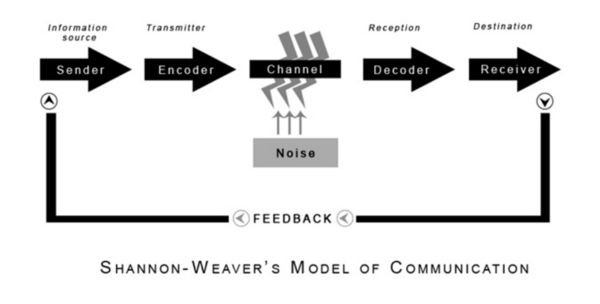
Transmission model – Shannon and Weaver model of communication was introduced in 1948 by American mathematician, electronic engineer Claude Elwood Shannon and scientist Warren Weaver in the article’’ A Mathematical Theory of Communication’’ published in ‘’Bell Labs Technical Journal’’. They were working in the telephone industry and came up with the simple model in 1940’s, that covers a linear conversation. This model was ‘’ an eye-opener’’ for communication theory models, that later on developed and models were introduced.
The model is designed with a main focus of information that can be defined as the sending and receiving of a particular message to create shared meaning. Typically used for nonverbal technology, a one-way model.
Information source, a sender – Person A sends an information, a message.
Transmitter, encoder'' – The information encodes into a message, it could be into a language.
Channel, Noise – The message transmits through a channel. Noise is caused by people or environment and changes the meaning of the transmitted source.
Reception, Decoder – The message is now decoded to the receiver.
Destination, Receiver – Person B receives the message.
Interaction model – Paul Watzlawick
Paul Watzlawick was an Austrian psychologist who had PhD degree in philosophy, studied psychotherapy in Switzerland at the Carl Jung Institute, and was also a professor at Standford University. With his background and knowledge, he and some other of his colleagues introduced this theory with the statement of ‘’ You cannot not communicate’’
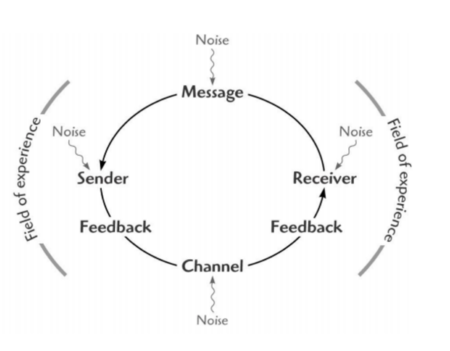
This model is based on interactional communication. Compared to the Shannon and Weaver model where the meaning is in words, this model focus on the meaning in people. In other words, the shared meaning is through people and not words. People are senders and receivers at the same time. It’s a two-way, not a one-way, communication theory.
We are both senders and receivers simultaneously.
To understand the interaction theory model, there are five axioms that are defined:
1. ‘’One cannot not communicate’’ – A person will always communicate somehow, whether it’s nonverbal or verbal, there will be some signals and body language that will be expressed.
2. ‘’The content and relationship levels of communication, metacommunication’’– Depending on which social scene you are in, the interpretation of the communication can vary. People will construe your message differently based on the relationship you have to one another.
3. ‘’Punctuation of the sequence of events’’ – Each participant will punctuate each sequence differently in an interaction, according to their own experience and personality. In a communicative event "every item in the sequence is simultaneously stimulus, response, and reinforcement" [[6]]
4. ‘’Digital and analogical communication’’ – Verbal and nonverbal communication can be interpreted in various ways. It’s not what you say, but it’s how you say it, that the receiver will interpret the message. Digital communication is most likely to be the word that is used in a context without expressing the sequence of the message, whereas analogical communication has both the context and the expression. Analogical communication has both verbal and nonverbal message in a conversation.
5. ‘’Symmetrical and complementary interaction’’ – This axiom defines the relationship between the communicators. Symmetrical interaction is when everyone is equal in their power status. This can be the relationship between two colleagues, brothers and sisters and so on. Complementary interaction is the opposite to symmetrical, where the power of status is different, there is a hierarchy. It could be the relationship between an employee and the manager, student and a teacher, father and his son and so on.
Transactional model – Dean Barnlund
Dean Barlund was an American communication educator who in the 1970’s created the Transactional model of communication. The model defines the individuals that are simultaneously involved in sending and receiving a message, it’s a two-way model. Interpersonal communication is the main focus, where more individuals are involved in an event. Each person decodes a message according to their culture, ethnicity, experience and educational background.
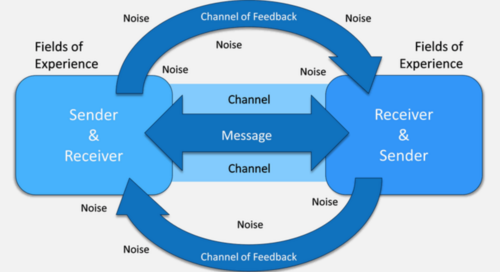
Dean Barnlunds five principle
1. Communication is not a thing, it’s a process
2. Communication is not linear, its circular
3. Communication is complex
4. Communication is irreversible
5. Communication involves the total personality
Transactional model would be common to use in a project where there is interpersonal communication.
When it comes to communication in a project where several parties are involved on international basis, there would occur some misunderstandings. This will occur because the way a human being interprets the message depending on many factors, such as experience and background.
Communication within a project and program management
To avoid misunderstandings and to ensure successful communications, four core elements can be defined.
• Stakeholder identification and analysis
The audience needs to be identified to ensure they get the right message.
• Message clarity and consistency
Ensure a clear and relevant message to gain the trust. Everyone interprets the message in their own way, and there for it’s important that the message is clear.
• Effective system of message delivery
Ensure the stakeholders receive the message in an effective way, within an effective time. An agreement can be set up on the system the communication channel has to be processed through. It can be a channel that all parties are familiar with, to provide a clear understanding of the messages.
• Feedback collection system
Feedback for the effectiveness of the communications process. It’s important to evaluate and to have some feedback for the systems that are used between the stakeholders. The earlier a problem or a misunderstanding is addressed, the less potential there is for a damaging consequence with a possibility of eliminating the consequence entirely if executed effectively.
Communication Plan Components
Engaging stakeholders regularly in the process of the project will lead to a successful project. An excellent tool for the engagement can be project communications plan, where the following is defined:
• WHO? - Identify audience for the project - It’s important to identify the stakeholders in order to organise the communication by shared interests. A stakeholder register is an option in some in organisations to outline the key reference for stakeholder profiles, which makes it easier to understand what the specific interest the stakeholder represents on a program board.
• WHAT? – Determine massaging type - With a stakeholder’s map and stakeholders’ profile it’s easier to analyse what the different stakeholders have in terms of interest, influence and power on the programme’s projects. With an influence/interest matrix a stakeholder’s role can be identified upon the project’s outcome. The higher the interest, the higher influence would lead to a high impact on the project. Stakeholders interest and influence can be changed during the process depending on the phase in the project. An agreement has to be set on which communication channels, programmes, and the frequency of engagement with the stakeholders.
• HOW? – Delivery method - “How will the programme effectively engage with stakeholders” The programme management team has to ensure the engagement of the stakeholders and how everything should be managed; from communication platforms, clarity of communication, to meetings, feedback, changes and plans.
• WHEN? – Determine frequency of schedule - A programme communication plan can determine the frequency of the communication to avoid misunderstandings by having scheduled meetings daily, weekly, monthly, when reached a milestone or as needed. Meetings can be scheduled depending on which task it is. It could for instance be on the construction site where a daily meeting is needed.
• OWNER? – Message source - The “owner” of the message is the one who is trying to communicate the effectiveness of the project to the audience, which could be the stakeholders.
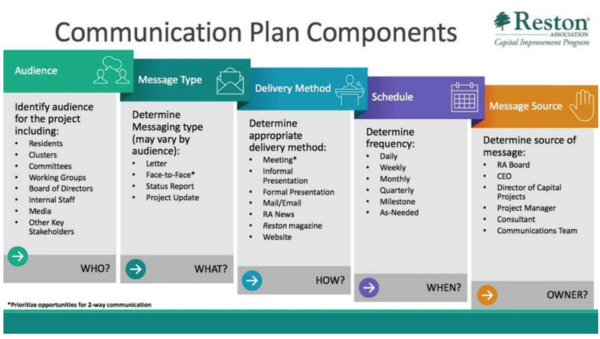
When everyone in the project are knowledgeable about the chosen components in a plan, it is easier to communicate and understand the message.
This will ease the process in the project and provides a successful organising structure. By having a communication plan, feedback will be provided and the communication will be two-way, where there is the opportunity to rectify a misunderstanding without causing major failure to the project.
Limitations
When it comes to communication three communication models have been analysed to give a better understand of how people communicate to prevent communication failure.
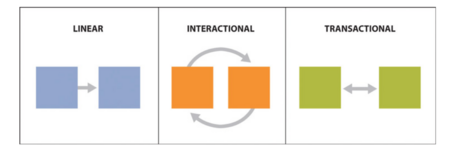
Transmission model is a one-way model of communication and one of the first communication models, which is mostly used for sending/sharing a massage and doesn’t not explain the understanding and the emotions in the message compared to the other communications models. It’s a linear communication model. This means that there is no feedback when a message is sent, it’s more like sending some information from A to B. Shannon and Weaver model was convenient in the 1948’s where the communication mostly happened by telegraph, letters, radio and TV.
Interaction model which is a two-way communication model, is used to define how individuals communicate with a sender and receiver. Taking into account that emotions and experience form the understand of how the message will be interpreted. It’s a circular conversation and not a linear conversation. It can be a conversation between two people, where they communicate about a subject. Non-verbal and verbal communication is defined in this model. Disadvantage of this communication form is, if the participants is from the same hierarchy, and wants to take a decision, in for instance a project, and both have different decisions without compromising.
Transaction model which is a dynamic, two-way communication model and a circular model, is defined where the participants in the models are mentioned as “communicators”. It’s used for interpersonal conversations. The message in this model is not only formed by the individual based on their experience and background, but also from their culture, ethnicity, behaviour and experience. This model is used where several people are communicating in an event, such as in a meeting. Simultaneous message sending, where the communicators have a shared field’s experience. The disadvantage of this model is when all the communicators are communicating at the same time in a meeting, then the person who is presenting will not be able to present the message of the presentation.
With today’s technology in regards to communication, projects and meetings can be run virtually where a person can be sitting in a meeting room hundreds of miles away and have a virtual meeting with another person or team on the other side of the globe, through a skype or a teams meeting and still get the feeling of being in the same place without actually being in the same place. You see the people in the meeting and when they speak, you see the way they express themselves by body language and the way they gesticulate. All this helps the individual to understand the shared message and minimises the risk of misunderstandings that could occur if it was just a message through mail or telephone.
Overall when analysing the communication models, it provides an understanding of how individuals react and understand a message. Therefore to ensure good communication, everything has to be clear to all parties that are participating in a conversation.
Annotated Bibliography
Managing successful programmes 2011 edition is a British standard for programme management where this reference is used in the part of the article where communication in programme and project management is defined. The standard has a framework on how to manage programmes successfully in all kind of projects to deliver the best outcome. [[7]]
Reference
[[8]] [[9]] [[10]] [[11]] [[12]] [[13]] [[14]] [[15]] [[16]] [[17]] [[18]]